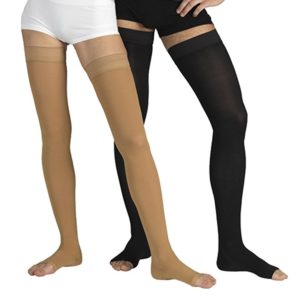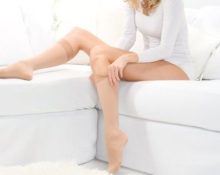Problems with veins and congestion in the lymphatic system require wearing specialized underwear. For example, compression stockings. This type of therapeutic knitwear is intended for independent use. It is worn either all day or only a few hours a day. The product is removed at night, but this rule has its exceptions. The method of application depends on the model of stockings and the patient’s condition. How to choose such stockings?
What types and classes of compression hosiery exist?
The main classification divides compression garments into 3 categories:
 hospital;
hospital;- preventive;
- medicinal.
The first type is used in a hospital setting. The second helps to avoid vein pathologies. People turn to him when the first symptoms of varicose veins appear and if there is a tendency to the disease. Well, therapeutic knitwear is included in the complex therapy of a number of diseases of the lymphatic and circulatory systems.
Important! Stockings are not suitable for monotherapy.In parallel with wearing therapeutic knitwear, you need to take medications, do exercise therapy, go for a massage and follow a diet.
Depending on the purpose and method of use, compression stockings are divided into 4 types according to the degree of compression:
- First compression class. The products are recommended for people who spend a lot of time on their feet or in a sitting position, have a predisposition to varicose veins, or have already discovered the initial signs of diseases of the lymphatic or circulatory system.
- Second class. The most commonly used linen. It is used in the treatment of varicose veins and thrombophlebitis, including in hospital settings.
- Third class. The products are intended for severe, aggravated and advanced forms of diseases of the venous and lymphatic systems.
- Fourth grade. Almost not in demand. It is used for a limited list of pathologies of the lymphatic system.
- Zero class. The product is characterized by a minimum degree of compression. Suitable for preventing congestion and relieving leg fatigue. Stockings of this class are included in the list of things that pregnant women need when entering the maternity ward. Athletes use them.
Knitwear is also distinguished by its appearance. Colored, black and flesh-colored products are available. The last option is not much different from nylon stockings. The traditional black version can be aimed not only at female, but also at male audiences.
How do compression stockings work?
 They act as a modern alternative to elastic bandages, which, using all-round compression, reduced the lumen of the veins. Bandages have been abandoned almost everywhere, since the average person does not have the skills necessary to properly apply such medical devices, and therefore is not able to use them on their own on a daily basis.
They act as a modern alternative to elastic bandages, which, using all-round compression, reduced the lumen of the veins. Bandages have been abandoned almost everywhere, since the average person does not have the skills necessary to properly apply such medical devices, and therefore is not able to use them on their own on a daily basis.
Compression stockings are much more convenient in this regard. They can be put on and taken off without the help of others. Due to this, it is easy to adapt to the doctor’s requirements regarding the duration of wear, and also to avoid unwanted excessive pressure on the walls of blood vessels and veins.
Important! Stockings work in the same way as elastic bandages. They comprehensively compress the leg, due to which the dilated veins narrow, ascending blood flow is established and the symptoms of lymphatic and circulatory stagnation are eliminated.
The safety of this type of therapeutic knitwear becomes obvious when compared with other products with a similar operating principle. If compression tights compress the pelvic organs, which in the long term can lead to diseases of the genitourinary and digestive systems, as well as provoke intoxication of the body, then the stockings only affect the legs.
Moreover, maximum compression is observed in the lower part of the limbs, and the thigh area is practically not involved. This localization makes it possible to avoid unnecessary compression of peripheral nerves and vessels, that is, to eliminate the factor contributing to the development of thrombosis.
Important! Compression of stockings in the lower leg area: 100%. Compression of stockings in the thigh area: 30–40%.
Stockings are also much easier to put on and take off. The value of this quality is revealed with daily use. Women who wear compression tights often complain that regular trips to the restroom take up too much time.And all because of the difficulty of handling therapeutic tights. Stockings end below the groin line, and therefore their influence on the owner’s lifestyle is less pronounced.
When are they needed?
 Stockings of zero and first compression classes are intended primarily for the prevention of varicose veins. The disease is clearly hereditary: venous weakness is passed on from generation to generation.
Stockings of zero and first compression classes are intended primarily for the prevention of varicose veins. The disease is clearly hereditary: venous weakness is passed on from generation to generation.
However, in addition to genetic prerequisites, the disease requires an activating factor. If you lead a sedentary lifestyle and spend 6–8 hours sitting at your desk every day, this can be regarded as a signal that you need to purchase compression hosiery with the lowest compression rate.
Other reasons to purchase 1st class compression stockings:
- systematic lifting of weights (due to official duties, for example);
- preparation for childbirth (during delivery, any type of weakness of varicose walls can develop, from hemorrhoids to varicose veins of the legs);
- wearing high-heeled shoes every day;
- the presence of diseases that affect blood flow in the extremities (but not diseases that narrow the venous lumen).
Important! Compression stockings are worn not only for varicose veins, but also for thrombosis, lymphedema, and thrombophlebitis.
The presence of symptoms of varicose veins – evening swelling of the legs, night cramps, the appearance of a “mesh” on the lower extremities – necessarily requires the use of compression hosiery. However, you should not purchase it yourself. It is necessary to consult a phlebologist. It will determine:
- at what stage the disease is;
- what compression class is required;
- duration of wearing (how many hours a day you will need to wear stockings).
Permission to use medicinal knitwear must be obtained not only from a phlebologist, but also from a cardiologist. Reason: Some cardiovascular diseases can be aggravated by the compressive action of compression stockings.
Contraindications for stockings
It is not advisable to use therapeutic stockings for the following diseases, conditions and factors:
 endarteritis;
endarteritis;- chronic low blood pressure;
- atherosclerosis;
- diabetes;
- bedsores;
- thromboangiitis;
- septic phlebitis;
- signs of atrophy of the muscular layer of the venous walls;
- pulmonary and heart failure.
Persons prone to irritation of the skin and follicles must obtain permission to wear from a dermatologist. Reason: compression hosiery, especially if chosen incorrectly, can act as a prerequisite for the development of infectious skin diseases. The following factors lead to this development of events:
- incorrectly selected or very high compression;
- untimely washing of stockings (according to the rules, they should be washed every evening);
- diseases that prevent normal renewal, healing and nutrition of skin cells;
- diseases that manifest themselves as rashes or formations on the skin;
- high sensitivity of the epidermis, tendency to irritation.
Important! The heat does not require the use of corrective or compression hosiery. Wearing it on a very warm day significantly increases the risk of developing skin diseases, and also has a negative effect on sweating and heat transfer.
Criteria for choosing compression stockings
 Price should not be the guiding factor. Even though compression class 1 stockings cost significantly less, their compressive ability may not be enough.In this case, wearing knitwear will not be beneficial.
Price should not be the guiding factor. Even though compression class 1 stockings cost significantly less, their compressive ability may not be enough.In this case, wearing knitwear will not be beneficial.
It is necessary to determine in advance what clothes the stockings will be worn under. This moment will allow you to choose between colored, transparent, nude and black knitwear models.
Medicinal products should be purchased only through pharmacy chains. You will not be able to check the medical quality of the product yourself. To avoid purchasing and further using stockings that actually do not have any beneficial properties, do not turn to online resources or regular underwear stores.
For operation
Anti-embolic hospital stockings are designed to reduce the likelihood of congestion in patients who are temporarily limited in physical activity. For this purpose, grade 0 and grade 1 compression stockings are used.. Allowable compression ratio: 15–21 mm Hg. Art. The more accurate range is determined by the doctor based on the type of surgery.
Important! Compression garments reduce the risk of venous disorders in the postoperative and postpartum period by 2 times.
Type of operation and class of stockings:
- During gynecological operations, knitwear with a compression degree of 18–21 mmHg is often used. Art.;
- the second class is assigned to patients and patients who, by the time of surgery, have already been diagnosed with problems with the elasticity of blood vessels and veins;
- during operations involving long recovery bed rest, the degree of compression is gradually increased, but starting with class 0 stockings.
Important! During natural childbirth, a healthy woman usually needs class 0 underwear. It is he who is taken with them to the maternity hospital, unless there are other recommendations from the doctor.
For varicose veins
Determining the required degree of compression should be entrusted to a specialist.Sometimes the disease occurs in a latent form for a long time, and therefore its external manifestations - the presence of stars and a venous network - cannot be the main guideline.
Important! For varicose veins, compression class 2 or 3 stockings are prescribed.
 If the disease progresses and the specialist has prescribed the wearing of compression class 3 underwear, try to purchase a model that includes threads coated with silver ions. The technology is called Clima Fresh. Due to it, the hygiene of stockings is increased and the likelihood of skin problems is reduced.
If the disease progresses and the specialist has prescribed the wearing of compression class 3 underwear, try to purchase a model that includes threads coated with silver ions. The technology is called Clima Fresh. Due to it, the hygiene of stockings is increased and the likelihood of skin problems is reduced.
In very severe cases of varicose veins, the doctor may prescribe the temporary use of class 4 medical knitwear. However, there must be serious reasons for such a decision, since such a degree of compression of the limbs can lead to irreversible damage to tissue trophism. For this reason, high-compression underwear has been withdrawn from free sale. It is sold only through a limited number of pharmacies and only if you have a prescription written out in accordance with all the rules.
How to decide on the size?
Incorrectly selected therapeutic knitwear not only does not bring benefits, but can also cause skin or vascular pathology. To prevent this from happening, you need to take measurements before purchasing stockings. Measurements are taken in the morning. At this time of day, swelling is either completely absent or not so pronounced.
Measurements are taken along 4 lines or parameters. Measured indicators:
- diameter of the lower leg (at the narrowest point);
- leg length (from hip to heel);
- thigh diameter;
- diameter of the lower leg (at its widest point).
If you don’t have the skills to take measurements, then it’s better not to risk it and ask the seller for help. They should provide customers with comprehensive assistance in selecting goods.
size table
There is a special table, based on which it is easy to determine the appropriate size of knitwear. It is universal, but some manufacturers use their own scale and marking method. Before purchasing, check with the seller about this point.

Brands worth choosing
The products of the following companies are in demand:
- Julius Zorn;
- Ecoten;
- Bauerfeind;
- Ortho;
- Medi Bayreuth;
- Intertextile;
- Ofa Bamberg.
Phlebologists often recommend products from Germany and Switzerland. These manufacturing countries place the highest demands on manufactured medical products. Only truly high-quality, safe and useful stockings receive a certificate.


 hospital;
hospital; endarteritis;
endarteritis; 0
0





